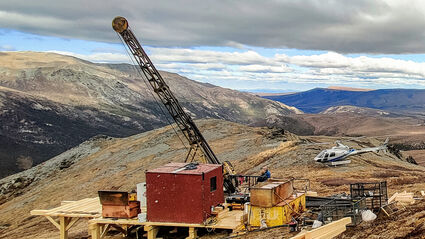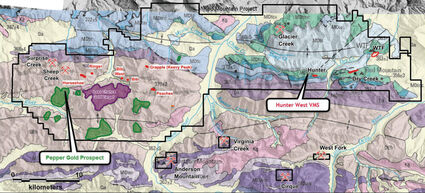White Rock explores two fronts in Alaska
Mining Explorers 2021 - January 27, 2022
Last updated 1/26/2022 at 4:11pm

White Rock Minerals Ltd.
This resource expansion hole at the Dry Creek deposit on the Red Mountain property cut 1.4 meters averaging 35% zinc, 12.2% lead, 237 g/t silver, 2.9 g/t gold, and 0.3% copper.
Since first coming to Alaska to explore zinc-rich volcanogenic massive sulfide deposits at Red Mountain, Australia-based White Rock Minerals Ltd. has continually added zinc-silver and gold targets within and on the outskirts of this project that has now been expanded to 323 square miles (836 square kilometers).
The company's 2021 drill program tested high-grade zinc-lead-silver-gold VMS targets that attracted it to Red Mountain in the first place and the intrusion-related gold targets discovered at Last Chance area at the western end of this district-scale property.
"The dual opportunity to explore an exciting new large orogenic-intrusion-related gold system and a potentially world-class volcanogenic massive sulfide district at a time when all metals are heading into a resounding bull market puts White Rock in a league all by itself," said Quinton Hennigh, a technical advisor to White Rock Minerals.
The 2021 drilling got started at Dry Creek, a silver-rich VMS zinc deposit at the eastern end of the Red Mountain Property.
Dry Creek and the nearby WTF deposits host 9.1 million metric tons of Australian Joint Ore Reserves Committee- (JORC) compliant inferred resource averaging 5.8% (1.17 billion pounds) zinc; 2.6% (516 million lb) lead; 0.1% (26.5 million lb) copper; 157 g/t (46.1 million oz) silver; and 0.9 g/t (260,000 oz) gold.
This year's drilling at Dry Creek tested the down-dip expansion potential of the resource with 200-meter spaced holes along a 1,000-meter stretch of the deposit.
The spectacular zinc grades in the first hole drilled in 2021 indicate the significant growth potential of this deposit.
From a depth of 487.1 meters, hole DC21-97 cut 5.8 meters averaging 11.5% zinc, 3.4% lead, 69 g/t silver, 0.8 g/t gold, and 0.1% copper. This zone of VMS mineralization included a 1.4-meter interval averaging 35% zinc, 12.2% lead, 237 g/t silver, 2.9 g/t gold, and 0.3% copper. This equates to 55.3% zinc if you calculate the zinc value of all the metals intercepted.
What is equally exciting to White Rock is this intercept is more than 200 meters down-dip from the nearest intersection in hole DC18-773, which cut 4.3 meters averaging 4.8% zinc, 2.3% lead, 1,435 g/t silver, 2.2 g/t gold, and 0.5% copper. The new intercept doubles the known depth of the resource in this area of the Dry Creek deposit.
Drills also tapped zinc-rich VMS mineralization at Hunter West, a target about three miles (five kilometers) southwest of Dry Creek.
White Rock geologists discovered Hunter in 2018, and one hole drilled that year, HR18-01, cut 1.4 meters averaging 17.4% zinc, 3.9% lead, 90 g/t silver, and 1.6% copper.
The second Hunter hole, HR18-02, cut 1.8 meters averaging 13.8% zinc, 3.1% lead, 56 g/t silver, and 0.9% copper.
Targeting the fault displaced down-dip continuation of this mineralization, HR21-07 cut 0.2 meters averaging 11.9% zinc, 2.8% lead, 0.9% copper, 63 g/t silver, and 0.2 g/t gold, from a depth of 184.8 meters.
White Mountain says the mineralized horizon at Hunter West can be mapped for more than 1,000 meters along strike from the fault offset. While the mineralization continues to be narrow at Hunter, VMS deposits often pinch and swell.
The company says future work at Hunter and Hunter West will use a combination of geology, structure, and geophysics to identify areas to test for thicker zones of mineralization.
On the gold front, geological reconnaissance has identified Pepper, a gold prospect about 22 miles (35 kilometers) west of the Hunter prospect area.
Pepper lies about three miles (5 kilometers) west of Last Chance, an intrusion-related gold discovery where 2020 drilling returned grades as high as 24.8 grams per metric ton gold over 1.2 meters.
Prospecting and sampling carried out at Pepper last year had identified four distinct areas, separated by talus cover, that extend for more than 1,000 meters.
Rock chip grab samples collected outcrop at Pepper returned assays with up to 6.5 g/t gold, along with associated silver, arsenic, and antimony. Soil samples of talus fine material returned up to 1.7 g/t gold, along with anomalous in arsenic and antimony.









Reader Comments(0)